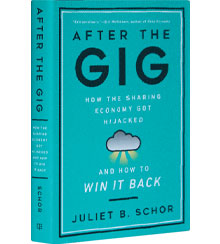Is the gig up?
In her new book, Boston College professor Juliet Schor reports on the ways that the sharing economy has — and has not — lived up to its initial promise.
A version of this article appeared in the Spring 2021 issue of strategy+business.
After the Gig: How the Sharing Economy Got Hijacked and How to Win It Back
by Juliet B. Schor, University of California Press, 2020
A decade ago, advocates touted the sharing economy as an alternative to corporate capitalism. Digital technology was opening vast, new peer-to-peer marketplaces: TaskRabbit and Airbnb were founded in 2008, Uber in 2009, RelayRides (now Turo) in 2010, Postmates in 2011, Lyft in 2012. These platforms promised that people would be able to make a good living while working when and how they wanted — selling their time and skills, and renting out their cars, spare bedrooms, and that dusty camping gear in the attic.
“You will know by now that things haven’t turned out exactly as expected,” Juliet Schor wryly notes in her new book, After the Gig. Schor, a sociology professor at Boston College, and her team at the Connected Consumption project, funded by the MacArthur Foundation, studied gig workers and platforms of the sharing economy from 2011 to 2017. The result is a more nuanced view than has been offered by previous books on this topic, which typically focus on either how companies can build their own platforms or how platform companies prosper by evading regulation and exploiting workers.
Among the insights: The less you actually need a gig job, the more likely it is that a gig job will work for you. “Workers’ experiences are not uniform, with variation in pay rates, job satisfaction, and how they do the work,” Schor explains. “As we saw these differences playing out at individual companies, we realized that they are explained by how dependent the worker is on income from the platform to pay basic living expenses.” Schor’s team found that supplemental workers — that is, workers who are not financially dependent on their platforms — make more money, have more autonomy, and are more satisfied with their gigs than platform-dependent workers. Moreover, the former group comprises 34 percent of the workers in the sample the team studied; the latter was only 22.5 percent. (The rest, nearly half of platform workers, fall between the two extremes.)
This finding partly contradicts the headlines of worker abuse that have generated a lot of political Sturm und Drang lately. At the same time, it is clear that the gig economy can’t really substitute for a full-time job. As Schor concludes: “With some exceptions, our data suggest that being dependent on a platform is not a viable way to make a living.”
With some exceptions, our data suggest that being dependent on a platform is not a viable way to make a living.“
And that was before COVID. Schor reports that, even as unemployment was remarkably low and wages were rising before 2020, gig worker pay was falling, especially on labor-intensive platforms, such as those of ride-hailing and delivery companies (versus capital-intensive platforms, such as home- and car-sharing companies). Now that the ranks of the unemployed have roughly doubled, exceeding 11 million people in the U.S., for example, it’s likely that some of those individuals will turn to gig work and create more downward pressure on pay rates.
Still, Schor, an economist by training, isn’t ready to give up on the potential of the gig economy. In the final chapter of After the Gig, she mostly dismisses the idea that regulation can pave the way for a sharing economy in which gig workers get an equitable share of the rewards, citing the overwhelming market power of the dominant platform companies and their unwillingness to relinquish their data. Instead, she proposes a rebooting of the sharing economy through the development of platform cooperatives — picture an Uber or Airbnb that is owned and controlled by its workers.
Schor points to Stocksy United, a platform owned by the photographers who sell their images on it, as an example of such a business. The photographers make all the major decisions concerning the platform, and hire staff to run day-to-day operations. They also earn more on the platform than on other photo sites because founders and investors aren’t siphoning off a third or more of its revenues, as is common on other sites. (Reportedly, the co-op’s annual revenue in 2018 was US$11–$12 million.) “While Stocksy isn’t perfect,” writes Schor, “it is a genuine success story — with satisfied artists, strong revenue and growth, and commitment to its values.”
In promoting this solution to reclaiming the techno-utopian promise of the sharing economy, Schor harkens back to W.E.B. DuBois, who wrote, “For working people to be free, they must seize control of the means of production.” She is not the only academic to see the means of production as the key to overcoming the negative effects of digital technology: In a 2015 paper, Richard B. Freeman, the Herbert Ascherman Professor of Economics at Harvard University, argued that the only way a jobs apocalypse could be avoided was if workers owned a partial stake in the robots that threatened to replace them.
As appealing as the idea of platform cooperatives sounds, it’s hard to figure out how it squares with the research findings that precede it in After the Gig. Schor admits that Stocksy is “one of the few” successful worker-owned platforms. How would gig workers mount a challenge to the corporate-owned platforms that already dominate most, if not all, major peer-to-peer markets? Where would the needed funding come from to reach platform scale — and to defend that platform, if there were real money to be made? Schor says that city governments could create protected zones for worker-owned platforms. But thus far, few cities have succeeded in reining in any of the major corporate platforms, let alone shutting them out.
After the Gig offers a nuanced, research-driven view of the first decade of the sharing economy. But it’s hard to turn the last page without concluding that the innovations that were supposed to transform our working lives for the better haven’t yet delivered on their promise.
Author profile:
- Theodore Kinni is a contributing editor of strategy+business. He also blogs at Reading, Writing re: Management and is @TedKinni on Twitter.







